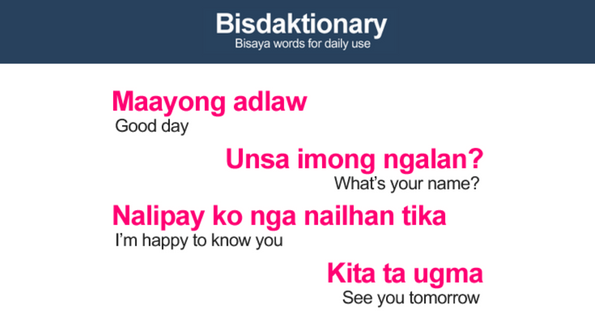Cebuano and Bisaya Language Guide

The Cebuano language, often referred to by most of its speakers simply as Bisaya (“Visayan”; not to be confused with other Visayan languages), an Austronesian regional language spoken in the Philippines by about 20 million people, mostly in Central Visayas, eastern Negros Island Region, western parts of Eastern Visayas and most parts of Mindanao, most of whom belong to the Visayan ethnic group, It is the most widely spoken of the languages within the so-named Visayan language family and is closely related to other Filipino languages
It has the largest native language-speaking population of the Philippines despite not being taught formally in schools and universities until 2012 It is the lingua franca of the Central Visayas, eastern Negros Island Region (especially Negros Oriental), western parts of Eastern Visayas and most parts of Mindanao. The name Cebuano is derived from the island of Cebu, which is the urheimat or origin of the language
Cebuano is also the prime language in Western Leyte, noticeably in Ormoc and other municipalities surrounding the city, though most of the residents in the area name the Cebuano language by their own demonyms such as “Ormocanon” in Ormoc and “Albuerahanon” in Albuera
Cebuano is spoken on the island of Cebu and its 167 surrounding islands and islets, Bohol and Siquijor, eastern Negros Island Region (entire Negros Orientaland northeastern Negros Occidental), southern Masbate, western portion of Leyte, western Biliran, small parts of Samar and most parts of Mindanao, the second largest island of the Philippines.
Furthermore, “a large portion of the urban population of Zamboanga, Davao and Cotabato is Cebuano speaking”.
Some dialects of Cebuano have different names for the language. Ethnic groups of Cebuano speakers from Cebu are mainly called “Cebuano”, Cebuano speakers from Bohol are “Boholano/Bol-anon”, while Cebuano speakers in Leyte identify their dialect as Kana (Leyte Cebuano or Leyteño). Speakers in Mindanao and Luzon refer to the language simply as Binisaya or Bisaya.


Love seeing Cebuano language getting the spotlight it deserves! Such a rich and vibrant language with unique expressions that show the beauty of Cebuano culture. ✨ Anyone else here trying to learn it, or maybe it’s already your native tongue?
Absolutely! Cebuano is such a beautiful language with a lot of depth. It’s amazing how much culture and history are embedded in it.
Wait, are Cebuano and Bisaya the same thing? I always get confused!
Good question! Cebuano is a specific language, while ‘Bisaya’ is often used to refer to various Visayan languages, including Cebuano, Hiligaynon, and Waray. But in Cebu, people usually use ‘Bisaya’ to mean Cebuano specifically.
Can anyone share common Cebuano phrases for everyday use?
Sure! Try these: ‘Kumusta?’ means ‘How are you?’, ‘Salamat’ means ‘Thank you,’ and ‘Palihug’ means ‘Please.’ Super useful in daily conversations!